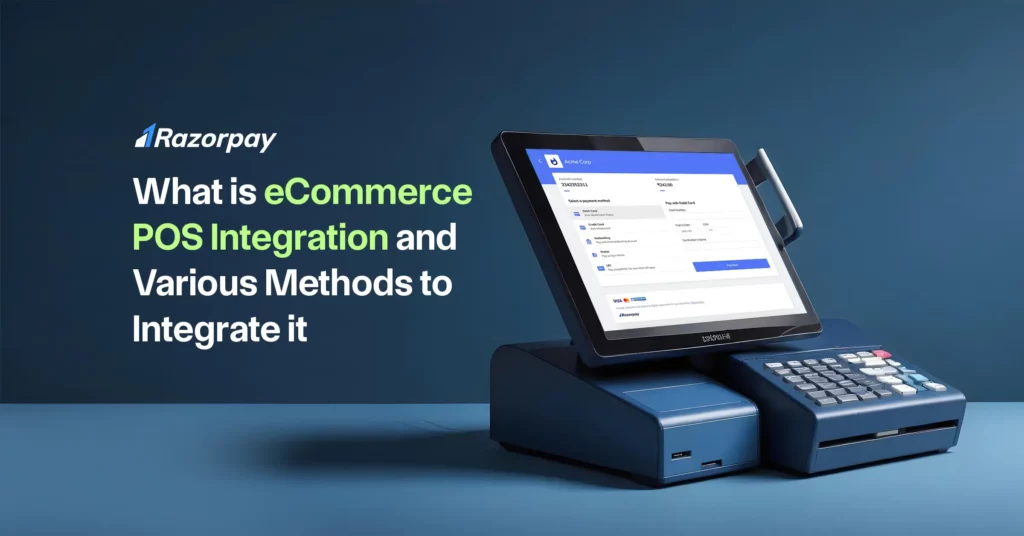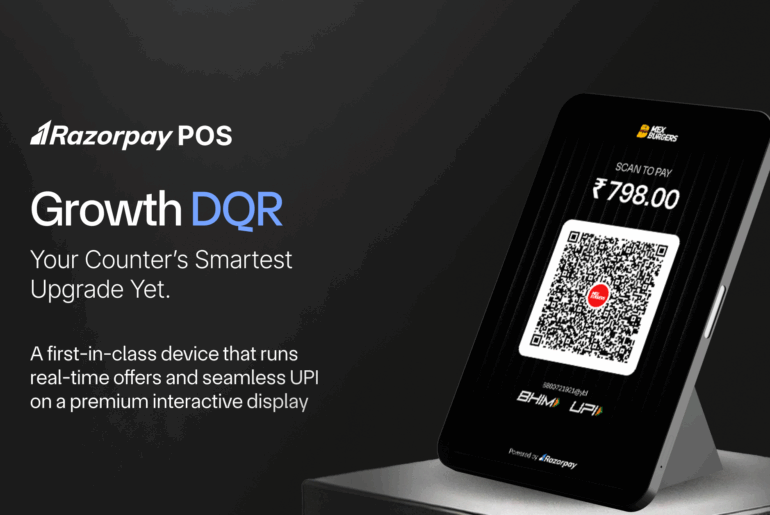e-Commerce POS integration refers to connecting and creating communication between two main business channels – an offline POS system and an online e-commerce platform. This integration is crucial as it helps businesses sync data, sales, and inventory across both channels, offering streamlined operations and shopping experience. This guide will cover the definition and importance of e-commerce integration, its methods, and the best POS system for businesses.
Table of Contents
What is an E-Commerce POS Integration?
e-commerce POS integration is a digital way of building a streamlined connection between the POS system and the e-commerce platform. This communication system lets businesses sync and pull data between the systems in real time. Through it, businesses can also process orders and transactions between online and offline channels.
For instance, by integrating e-commerce POS, a company may precisely monitor inventory levels by coordinating stock information from their physical and online stores. The POS system instantly updates its inventory count when a product is sold online, guaranteeing that physical stores display the right amount of stock.
Benefits of Integrating e-Commerce with a POS
A survey conducted by Harvard Business Review stated the possibility of consumers spending 13% extra while purchasing from offline or physical stores. However, it is only if they research the brand online before visiting the store. This study also shows that people who prefer interactions through multiple channels are more inclined to purchase in physical stores.
Therefore, it is essential to offer clients a smooth online to offline purchasing experience to satisfy their rising expectations.
Real-time Inventory Management Prevents Overselling
When POS system and e-commerce integration happens, inventory and stock are always up-to-date across all platforms. It also makes it easier for employees to find the inventory information in real-time along with product availability, thus avoiding overselling the products.
In addition, this point-of-sale e-commerce integration also helps avoid out-of-stock situations on both offline and online platforms. When the inventory is fully optimized, it becomes easier for businesses to restock the products.
Consider an example of a large retail store with an online presence. Using an e-commerce POS connection, they coordinate inventory data between their numerous physical locations and online shops. This real-time update improves consumer happiness and delivery times by enabling them to fulfill online orders from the closest area with available stock and preventing overselling.
Automate Data Entry, Reducing Manual Errors
Manual reconciliation, data entry, and synchronization are time-consuming and prone to human errors. Hence, when there is an integration between a POS machine and an e-commerce website, it eliminates the need for different kinds of manual work, such as synching order information from online and offline stores, managing orders, purchases, and customer information in one place, and reconciling data between two sources.
If automation happens, businesses can save time and effort in doing these manual tasks and focus on more essential tasks. For instance, a large retail chain uses an automated system to process multiple transactions daily. This automation helps handle orders, track shipments, and update inventory with complete accuracy and no human involvement.
Implement Cross-Channel Promotions and Discounts
Businesses often promote their products with discounts and offerings. However, it is necessary to have these promotions and discounts consistent on both platforms. When the offerings are the same on both platforms, it becomes easier for integration to streamline loyalty programs and improve customers’ shopping experience, eventually leading to increased sales.
This electronic payment system and e-commerce integration can help customers purchase from any platform, thus helping businesses expand their customer base. It can further benefit businesses by offering loyalty points and gift cards, which customers can use online and offline.
Utilise Customer Data for Better Insights
By integrating e-commerce and POS, businesses keep all the customer data in one central place. This can help in displaying consolidated consumer shopping behavior across both platforms. It can also offer valuable insights into customer’s shopping habits and preferences. Businesses can further use this data by providing tailored marketing proposals based on their purchase history.
They can also run promotions on both platforms, like reward cards, discounts, and loyalty programs. If businesses use this data, they will provide their customers with a consistent shopping experience, engagement, and interaction across platforms, leading to improved relationships.
Facilitate Omnichannel Order Fulfilment
There is a growing demand for omnichannel retailers with online and offline presence. More retailers are offering same-day delivery, where integrating an electronic point-of-sale (EPOS) system becomes crucial. This integration enables businesses to provide excellent customer experience without spending much.
With this integration, it is easy to move towards omnichannel order fulfillment that allows customers to purchase online and get orders from physical stores. Similarly, they can return damaged products at a nearby store. Big stores like Walmart also use physical stores to fulfill their orders. Thus, working on an omnichannel order fulfillment model.
Enhance Overall Customer Experience
Through their omnichannel model and integrated POS solutions, businesses offer excellent customer service by solving problems on a real-time basis. The physical stores are connected with POS to create a seamless customer experience by providing seamless online ordering, different payment methods, and integrated omnichannel marketing programs.
A seamless experience is crucial for businesses to retain customers and build brand image. Big stores can offer a hassle-free experience because of this integration. Customers of stores like Walmart can see the available products, place an order, and pick them up from the store. It brings customer loyalty and satisfaction.
Key Features to Look into an Integrated e-Commerce POS System
-
Inventory management integration
-
Exchanges and returns
-
Customer service
-
Card processing and Apple Pay procedures
-
Promotions and discounts
-
e-Commerce sales reporting
-
Contactless and digital payment integration
-
Fulfillment via several channels (omnichannel)
-
Loyalty programs in the form of gift cards, reward points, and store credit
-
Email marketing integration
-
Curbside or Buy Online, Pick Up in Store (BOPIS) service
How Does an e-Commerce POS System Integration Work?
It is essential to understand what is POS system and how it works with an online store. The POS system works by automating the execution of data sharing and retail processes between online and offline stores. It also syncs the catalog of products between online and brick-and-mortar or physical stores and ensures centralized product information management. Additionally, it automates the inventory updates for online and retail stores resulting in real-time inventory management and maintaining consistency across platforms.
This integration also offers a seamless data transfer between both platforms. It also provides a centralized solution for POS transaction processing across offline and online channels through integrated payment gateways.
Methods of Integrating POS with an e-Commerce Platform
There are many ways of integrating your e-commerce platform with a POS system. To decide the best method, you must evaluate your current situation based on the below scenarios:
When You Have a POS But No Website
If you have a POS system, it is easy to integrate it with any of the popular e-commerce platforms with an open API architecture. You can check with your existing provider regarding their e-commerce website integration options. There can be situations where you may have to build an e-commerce service for your POS system.
If satisfied, you can continue with your existing provider or look for a new one. Once you have finalized the provider, keep the following things in mind for successful integration:
-
Choose a Theme – While some e-commerce systems let you design your theme, others offer preloaded themes that must be customized to fit your brand’s identity and look.
-
Synchronise Payment Gateway – Configure or incorporate the payment solution providers into your POS system with your online website. Remember that processing costs for online sales are sometimes more significant than card transactions made in-store.
-
Import Inventory and Customer Data – The procedure may be precise and fast if you utilise a data migration solution to move inventory and loyalty points from the POS system to your website.
-
Shipping Options – Verify that the selected e-commerce platform can integrate or support your shipping providers and delivery costs.
When You Have a Website But No POS
You need a POS integration to expand your business from online to brick-and-mortar. The first step is to determine how to integrate the e-commerce platform with the POS system. Next, look for a POS system compatible with the chosen platform. Then check the checklist mentioned in scenario one along with other details, such as:
-
Payment Processor Integration – Ensure the POS is compatible or can integrate with the existing payment providers. Switching payment providers is not a desirable option.
-
Available Integration and Add-ons – Look for a POS system with additional features, like advanced reporting and inventory management.
-
Curbside Pickup – Customers prefer curbside pickup options for contactless payment and safety purposes. Look for a POS system that supports this option.
When You Lack Both a POS and a Website
Suppose this is the first time you are starting a business. In that case, you must research a provider with an all-in-one solution to integrate the POS system and e-commerce website and ensure seamless communication between online and offline channels.
Select a long-term technical solution partner and look for a point-of-sale system that integrates with a robust e-commerce platform, such as a Magento-native POS. They won’t pressure you to utilize pointless features, and they’ll provide you with a ton of professional guidance at reasonable costs.
What’s the Cost of e-Commerce and POS Integration?
Integrating your e-commerce platform with a POS system can help business owners, merchants, and individuals make informed decisions, but it’s crucial to understand the following cost factors:
1. Fee Structure for e-Commerce Platforms
e-commerce platforms come with diverse pricing models designed to cater to businesses of different sizes and needs. Typically, you’ll encounter monthly subscription plans or transaction-based fee structures.
The number of products you list and your monthly transaction volume can significantly impact your expenses. Some platforms may charge extra for exceeding certain limits, so it’s wise to project your growth and choose a POS charges plan that accommodates your future needs.
2. Registration Fee for POS Systems
When selecting a POS system, be aware that some providers require an initial registration fee. This upfront cost often covers setup, initial training, and sometimes hardware.
However, the POS market is competitive, and many providers offer free trials or promotional discounts for new users. These offers can be an excellent opportunity to test the system’s compatibility with your business before committing financially.
3. Integration Cost Between POS and e-Commerce Platform
The cost of integrating your POS system with e-commerce integration can vary widely. This expense depends on factors such as the complexity of the integration, the specific systems involved, and the level of customization required.
Some e-commerce and POS providers offer pre-built integrations, which can be more cost-effective. However, if your business has unique needs, you might require a custom integration solution, which typically involves higher costs due to the specialized development work involved.
It’s advisable to discuss integration options and associated costs with both your e-commerce platform provider and POS system vendor to get a clear picture of the investment required.
4. Development Fees for Extra Integrations or Features
As you delve deeper into the integration process, you might identify additional features or integrations necessary for your business operations. These could include inventory synchronization across multiple locations, customer data management, or advanced reporting capabilities.
Custom development work to implement these extra features can add to your overall costs. The expense will vary based on the complexity of the features and the expertise level of the developers. It’s crucial to clearly define your requirements and obtain detailed quotes from reputable developers or agencies specializing in e-commerce and POS integrations.
5. Payment Processing Charges
Online transactions processed through your e-commerce platform will incur payment processing fees. These fees typically consist of a percentage of the transaction value plus a fixed amount per transaction.
Several factors can influence these charges:
-
Transaction Volume: Higher sales volumes often qualify for lower rates.
-
Payment Methods: Different payment types (credit cards, digital wallets, etc.) may have varying fee structures.
-
Risk Level: Some industries are considered higher risk and may face higher fees.
-
International Transactions: Cross-border sales often incur additional fees.
Related Read: How to Choose a POS System?
Conclusion
There are several advantages to integrating point-of-sale (POS) systems with e-commerce platforms, such as better inventory control, simpler operations, and improved customer experience.
Selecting a trustworthy payment gateway such as Razorpay is essential for enabling safe and easy transactions between different channels. Razorpay provides features, including omnichannel payment acceptance, real-time analytics, and configurable solutions designed explicitly for e-commerce-POS integration. These functionalities enable enterprises to streamline their payment procedures, boost sales effectiveness, and propel expansion inside the digital commerce arena.
Frequently Asked Questions (FAQs)
1. What is payment integration with POS systems?
When a payment terminal is integrated with a POS system, your business can accept credit cards, debit cards, and mobile wallets, among other payment options.
2. Can I integrate my existing POS system with an e-commerce platform?
If you already have a point-of-sale system, you can integrate it with the most widely used e-commerce systems offering open API architecture. Find out from your Point of Sale (POS) supplier what alternatives are available for integrating with e-commerce websites.
3. What are some popular e-commerce platforms that offer POS integration?
Some popular e-commerce platforms offering POS integration are Shopify, Square, WooCommerce, BigCommerce, Wix, Big Cartel, Lightspeed, OpenCart, and Squarespace.
4. Are there any limitations or challenges associated with e-commerce POS integration?
Challenges, including exorbitant implementation costs, interoperability problems, data security difficulties, and the requirement for continual maintenance and upgrades, can arise when integrating e-commerce with point-of-sale systems.



